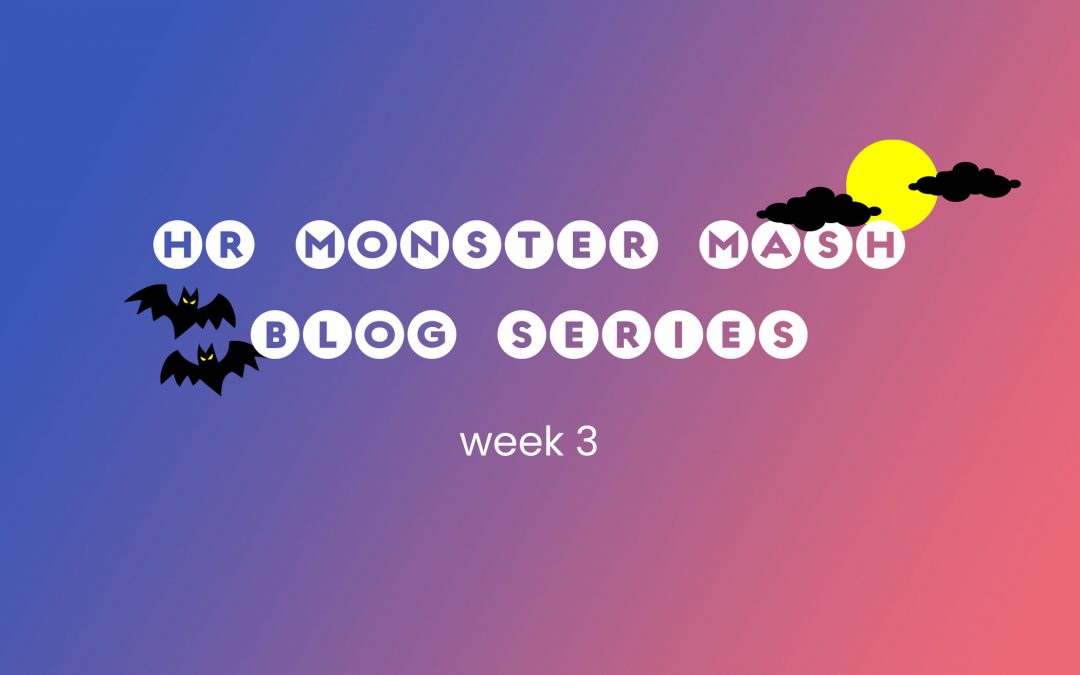 Welcome back to Week 3 of the HR Monster Mash!
Welcome back to Week 3 of the HR Monster Mash!
This week, we’re talking about Witches & Warlocks – employees who cast a spell on the work environment creating a toxic work culture. Toxic employees come in many forms, cause harm, and spread their bad behavior to others. Let’s review the cast of characters.
“Not my problem” and their cousin “Not my job” – This employee does the bare minimum to get by, complains when asked to help out, and if what is being requested doesn’t fall squarely in his or her ball court, good luck getting the assist! The risk here is this bare minimum attitude is contagious, other employees may decide it’s just the standard. So, what do you do? First, let’s look at what might be motivating this behavior. An employee may feel like the company doesn’t really care about them, they are just a “number” or “it’s just a job”. So, he or she does only what is required and is first out the door at closing time.
Employees may be more willing to go the extra mile if they feel leadership is willing to invest in their career development. Schedule some time for an open and honest career goals discussion. Set clear expectations, lay out a plan for career development with regular check-ins, holding the employee accountable for continued progress. With a little focused attention, “Not my problem” could transform into “Put me in coach!”
Eeyore – This employee is best described as mopey, depressed-like, and generally negative. While we want everyone to feel welcome to express their opinions, the Eeyore tends to only express negativity and focuses on the problem without bringing ideas for a solution. All you need do is turn on the evening news or look at social media to know, bad news is popular and can spread like wildfire!
While it may not be Eeyore’s intention to usher in the rain cloud, the negativity has the potential to be a real morale buster! Your employees may feel like they need to look at rainbows and kittens just to make it through the rest of the day after encountering an Eeyore.
There are a few things you might try in this situation. Set aside a few minutes of each team meeting and ask employees to share some positive news. Encourage, and potentially incentivize celebrating the successes of others. If you are in an office setting, you might keep blank notecards handy that anyone can grab to write an encouraging note to a deserving co-worker. Virtual notes are just as encouraging! Consider creating a contest where your team emphasizes positive feedback. An increasingly popular idea is an electronic system which awards points for praise, and then the points can be redeemed for merchandise.
Gossip Girl (not the TV series) – We all love a little drama, but the Gossip Girl (or Guy) is someone who thrives on drama and talks eagerly and casually about other people. They like to hear the latest news about people and may seek out opportunities to interact with others, intent on prying into everyone’s life, sucking up all the gory details like a vacuum cleaner on Sunday.
If it starts with “Did you hear” — just don’t.
So, what’s the best way to handle this issue? It’s simple— gossip should not be tolerated. A one on one meeting is a must. It’s important to let this employee know that his or her behavior is disruptive, unprofessional and diminishes the respect and dignity of other employees, be quick to set boundaries and stay firm.
“Not my Fault” – This employee refuses to admit when they are wrong, is quick to point the finger, and is more concerned with defending themselves than finding a solution to a problem. They don’t embrace the “we are all in this together” attitude, but rather only look out for themselves. In this toxic situation, it is important to listen first and to test the claims. Is the passing of the ‘proverbial buck’ a symptom of poor performance? Try assigning this employee more solo assignments, then carefully review their work. If there are no other co-workers to blame, any persistent claims of not being at fault will become more transparent. Better to remedy poor performance sooner, than later.
Toxic employees and the toxic culture they bring come with a price tag. Research shows that good employees are 54 percent more likely to quit a toxic work environment and team wide performance drops by 30 to 40 percent. What’s the best way to avoid a toxic employee culture? To not hire them in the first place. Careful screening and leadership development are the top ways to build a strong culture.
___
What did you think of the different types of witches and warlocks? Have you encountered any of these in the workplace? Let us know what you did to help solve the dilemma!

